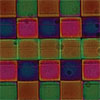| Dec 02, 2021 |
|
|
|
(Nanowerk News) Certain types of sensors detect and identify different types of hazardous pollutants, such as toxic or explosive gases. Some also measure gas concentration. The majority of our days are spent at home, work or travelling in our cars. Monitoring levels of pollutants reliably and in a cost-effective way should improve our overall health and well-being.
|
|
Scientists at Trinity College Dublin (TCD), Ireland, and the Science Foundation Ireland Research Centre for Advanced Materials and BioEngineering Research (AMBER), hosted by TCD, have discovered how to create tiny colour-changing gas sensors. To achieve this groundbreaking discovery, they used new materials and a high-resolution form of 3D printing.
|
|
The findings were recently published in the Journal of Materials Chemistry C (“Direct laser writing of vapour-responsive photonic arrays”).
|
Intelligent chemistry meets smart design
|
|
The 3D-printed, microscopic gas sensors can be monitored in real time and used to detect solvents that produce vapours in air. If inhaled, solvent vapours may cause coughing, dizziness and headaches. These sensors are a promising solution for use in homes as connected, low-cost devices. They can also be integrated into wearable devices for monitoring our health.
|
|
Lead author Dr Colm Delaney from ChemLife project coordinator TCD’s School of Chemistry and AMBER research fellow explains that the team achieved the innovation “by using a technique known as Direct laser-writing (DLW), which allows us to focus a laser into an extremely small spot, and to then use it to make tiny structures in three dimensions from the soft polymers which we develop in the lab.”
|
|
The research focused on these tiny structures’ design, modelling and fabrication in stimuli-responsive materials. The team developed designs and predicted the response of different structures. Co-author Louise Bradley, professor of photonics at TCD, discusses that the team can get the structures to “respond to light, heat, and humidity to create systems which can truly recreate the vividness, stealth response, and camouflaging ability found in nature. The tiny responsive arrays, which are smaller than a freckle, can be used to tell us an enormous amount about the chemistry of their environment.”
|
Pollutants worse than we thought
|
|
Co-author Dr Larisa Florea from the School of Chemistry and AMBER, provides some revealing statistics about pollutants in our homes, offices and cars. “Models suggest that the concentration of pollutants can be anywhere from 5-100 times the concentration found outside. This is a haunting thought when we consider that the World Health Organisation suggests 90% of the world’s population lives in areas which exceed acceptable air standard limits. These pollutants can be influenced by ambient air, chemical presence, fragrances, food quality, and human activity and have a profound effect on our health.”
|
|
Dr Florea concludes: “To date, indoor gas sensors have focused almost solely on leak, smoke, and carbon dioxide detection. Even iterative advances, to include relative humidity, oxygen levels, carbon dioxide, volatile organic carbons (VOCs), and ammonia in a real-time manner could play an enormous role in the development of a domestic environmental monitoring ecosystem. This could ensure that health and wellbeing monitoring become central to the future of home building and automation.”
|
|
The ChemLife (Artificial micro-vehicles with life-like behaviour) project runs until September 2023. The 5D NanoPrinting (Functional & Dynamic 3D Nano- MicroDevices by Direct Multi-Photon Lithography) project ends in August 2024.
|
